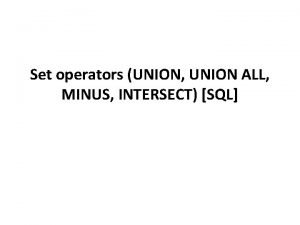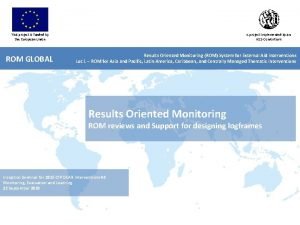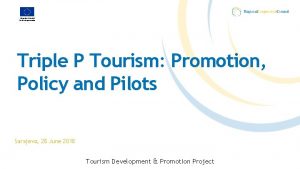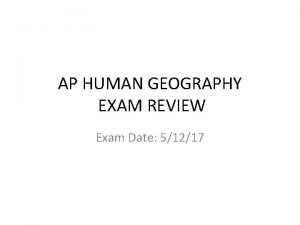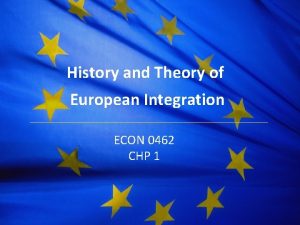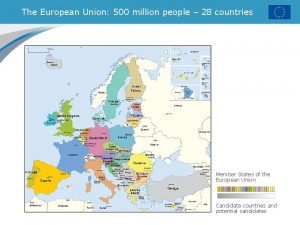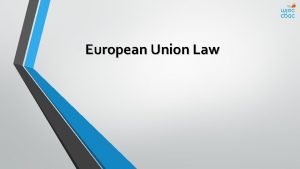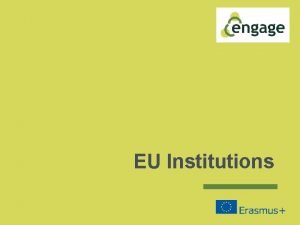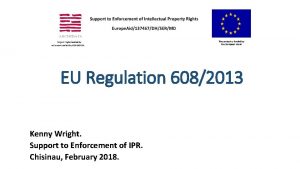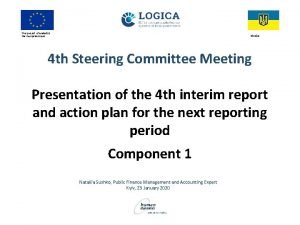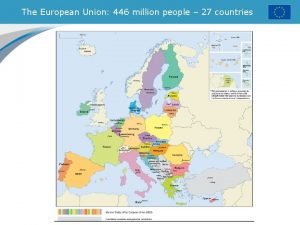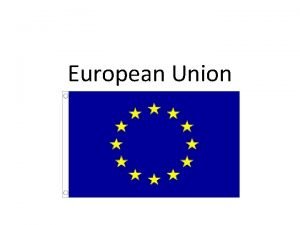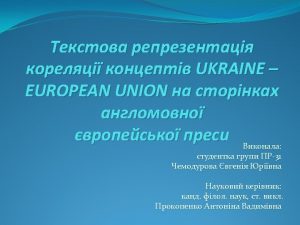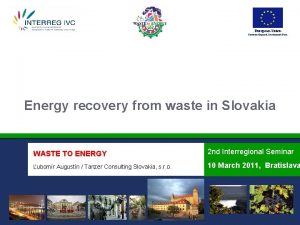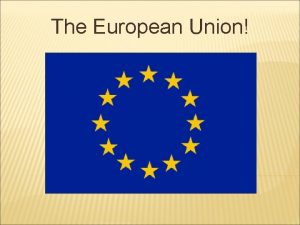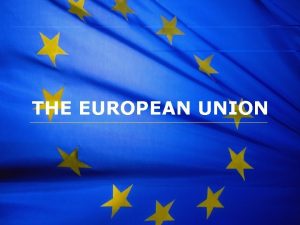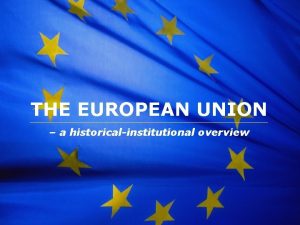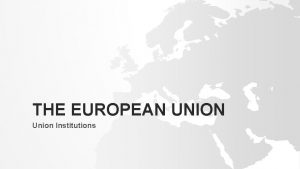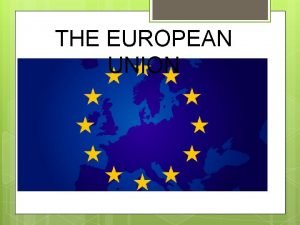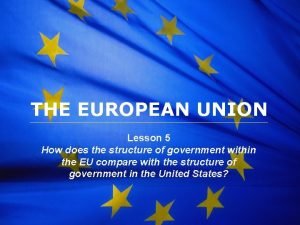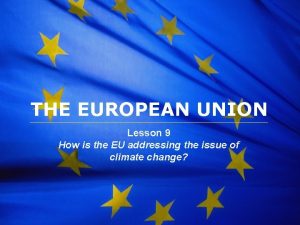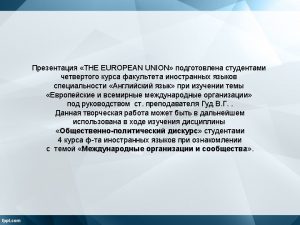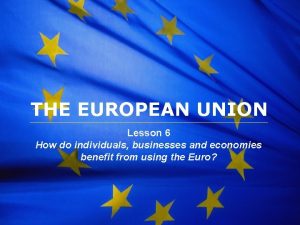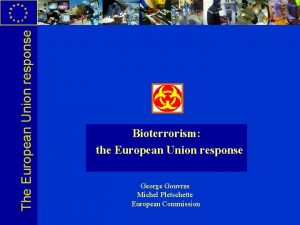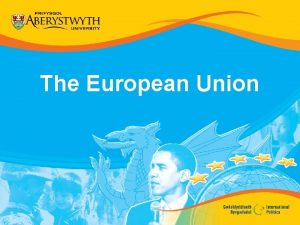The European Union What is The European Union






















- Slides: 22

The European Union

What is The European Union? • Shared values: liberty, democracy, respect for human rights and fundamental freedoms, and the rule of law. • The world’s largest economic body. • The world’s most successful model for regional integration and for advancing peace and democracy. • A unique institution as Member States voluntarily cede national sovereignty in many areas to carry out common policies and governance. • It is not a super-state which replaces existing states. Nor is it simply an organization for international cooperation.

Supranationalism • Supranational Organizations: organizations in which nations are not totally sovereign actors • Reflects trend of integration – Process that encourages states to pool their sovereignty in order to gain political, economic, and social clout

Why Form a European Union? • Began after WWII in an effort to repair nations’ economies in a war-torn Europe • Initial goals were almost completely economic in intent

Evolution of Integration • 1965 the EC (European Community) was established • Expanded the organization's functions beyond economics to include a unified approach to peaceful use of atomic energy

Finally, the EU! • 1991 the Maastricht Treaty created the modern organization and gave it authority in new areas • Important goal was to coordinate economic policies, particularly through common currency, the Euro

Finally, the EU! • The Treaty Established Three Pillars (spheres of authority) 1. Trade and economic cooperation 2. Law enforcement and human rights 3. Foreign policy and European security

Finally, the EU! • Basis of the EU: The European Union is based on the rule of law and democracy. It is neither a new State replacing existing ones nor is it comparable to other international organizations. Its Member States delegate sovereignty to common institutions representing the interests of the Union as a whole on questions of joint interest. All decisions and procedures are derived from the basic treaties ratified by the Member States

Requirements for Membership • A stable and functioning democratic regime • A market-oriented economy • Willingness to accept all EU laws and regulations

5 Main Institutions 1. European Commission – Seeks to uphold interests of the Union as a whole 2. Council of Ministers – Represents the individual member states 3. European Parliament – Represents EU’s citizens and is directly elected by them

5 Main Institutions 4. Court of Justice – Upholds the rule of European law 5. Court of Auditors – Checks the financing of the Union’s activities


Institutions – The Commission • 28 members, one appointed by each state’s govt (approved by EP) • Bureaucracy of several thousand European civil servants • Each commissioner takes responsibility for a particular area of policy • Main responsibility is to initiate and implement new programs • Forms a permanent executive that supervises work of EU (like a cabinet)

Institutions – The Council of Ministers • Composed of head of each member country (PM/Pres, etc) and Pres of EU Commission • The Commission may initiate legislation, but its proposals don’t become law until they have been passed by Council • Each country is assigned a number of votes in proportion to its share of the population

Institutions – The European Parliament (EP) Historically has not had a lot of legislative power 736 members directly elected once every 5 years May propose amendments to legislation May reject proposals from the Council outright BUT Council may override by unanimous vote • Gained more power with Lisbon Treaty (2007) • •

• • • Institutions – The European Court of Justice (ECJ) Supreme court of EU Has power of judicial review Interprets European law and its decisions may limit national sovereignty 28 judges, each nominated by different member state Cases are decided by simple majority

Key Policies – Single Market • Creating and maintaining a single internal market • Removal of tariffs/barriers • Most professional licenses accepted in all members states

Key Policies – Monetary Policy Union of monetary policy Control of money supply Power to set basic interest rates/fiscal policy is being passed from national banks/govts to European Monetary Union and its central bank • Common currency – Euro (exceptions: UK and Sweden) • • •

Key Policies – Agriculture • Common Agricultural Policy • Almost half of EU’s budget goes to this policy • Goal is to modernize inefficient farms so they can compete – Farm subsidies – Rural development projects

Key Policies – Defense • Common Defense • Crisis management – crises defined as humanitarian, rescue and peacemaking tasks • Goal is to be able to deploy up to 60, 000 troops within 60 days that could be sustained for at least one year • Commitment and deployment up to each member state

Key Policies – Justice/Home Affairs • Treaty of Amsterdam – aim was to establish free movement of EU citizens and non-EU nationals throughout Union • Involved setting policy regarding visas, asylum and immigration • Terrorism – EU and US officials have held a series of policy dialogues on border and transportation security

Current Issues • Enlargement – rapid growth has brought “enlargement fatigue, ” a loss of enthusiasm for further growth • Democratic Deficit: many people fear that the power shift from national to supranational institutions will result in loss of direct control of political decisions by the people (Euroskeptics) – Lack of accountability to average citizen
 Intersect and minus in sql
Intersect and minus in sql This project is funded by the european union
This project is funded by the european union European union military
European union military This project is co-funded by the european union
This project is co-funded by the european union This project is funded by the european union
This project is funded by the european union Eureka eurostars eligibility
Eureka eurostars eligibility Co-funded by the erasmus+ programme of the european union
Co-funded by the erasmus+ programme of the european union Borchert model ap human geography
Borchert model ap human geography European union history
European union history Co-funded by the erasmus+ programme of the european union
Co-funded by the erasmus+ programme of the european union Giorgi kacharava
Giorgi kacharava European union 28 countries
European union 28 countries Direct effect eu law
Direct effect eu law The european institutions
The european institutions This project is funded by the european union
This project is funded by the european union This project is funded by the european union
This project is funded by the european union European union 28 countries
European union 28 countries This project is funded by the european union
This project is funded by the european union Co-funded by the erasmus+ programme of the european union
Co-funded by the erasmus+ programme of the european union Etu taekwondo
Etu taekwondo Tư thế ngồi viết
Tư thế ngồi viết Thế nào là mạng điện lắp đặt kiểu nổi
Thế nào là mạng điện lắp đặt kiểu nổi Cái miệng nó xinh thế chỉ nói điều hay thôi
Cái miệng nó xinh thế chỉ nói điều hay thôi
